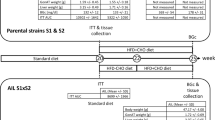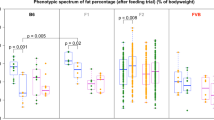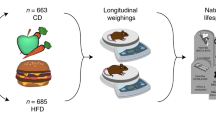Abstract
OBJECTIVE: For a detailed understanding of the complex traits growth and fat storage, a dissection into single genetic entities is mandatory. Therefore, blood plasma concentrations of hormones and the expression of selected genes were measured in extremely differentiated mouse lines. Genes were selected as candidates which might influence the complex traits body weight and fat accumulation, and which are located in chromosomal regions recently identified to affect trait differences between the lines.
SUBJECTS AND MEASUREMENTS: The mouse lines were selected for high body weight (DU6), high carcass protein content (DU6P) and unselected controls (DUKs). In the selected lines DU6 and DU6P, mean body weights at the age of six weeks were about twice as high as the DUKs, whereas total fat weight was increased 2.2-fold in DU6 mice compared to DU6P and 3.2-fold in comparison to DUKs. Blood plasma concentrations of insulin-like growth factor 1 (IGF-1), growth hormone (GH), insulin and leptin, were measured in all lines at three weeks and at six weeks of age. Expression patterns of the genes encoding growth hormone (Gh), insulin-like growth factor 1 (Igf1), lipoprotein lipase (Lpl), glycerolphosphate dehydrogenase 1 (GDC-1), and adipocyte protein 2 ( Ap2) were analyzed by Northern blot hybridization.
RESULTS: In line DU6, highly significant increased concentrations of insulin and leptin were observed at six weeks of age; at this stage, IGF-1 concentrations were elevated in the two selected lines compared to controls with maximal concentrations of IGF-1 and GH in DU6P. The amount of mRNA for GH in the pituitary gland, for Igf1 in the liver and for LPL in epididymal fat tissue was significantly elevated in the two selected lines compared to controls at the age of three weeks, but not at six weeks. IGF-1 and GDC-1 mRNA concentrations were significantly higher in the DU6 mice than in the DU6P (P<0.01) and the DUKs (P<0.001) mice examined at both ages.
CONCLUSIONS: The results prove line-specific concentrations of the analyzed hormones and the transcription amounts of Gh, Igf1, GDC-1 and Lpl. The measured differences are either direct genetic effects or secondary changes, resulting from different food consumption.
This is a preview of subscription content, access via your institution
Access options
Subscribe to this journal
Receive 12 print issues and online access
$259.00 per year
only $21.58 per issue
Buy this article
- Purchase on Springer Link
- Instant access to full article PDF
Prices may be subject to local taxes which are calculated during checkout
Similar content being viewed by others
Author information
Authors and Affiliations
Corresponding author
Rights and permissions
About this article
Cite this article
Timtchenko, D., Kratzsch, J., Sauerwein, H. et al. Fat storage capacity in growth-selected and control mouse lines is associated with line-specific gene expression and plasma hormone levels. Int J Obes 23, 586–594 (1999). https://doi.org/10.1038/sj.ijo.0800872
Received:
Revised:
Accepted:
Published:
Issue Date:
DOI: https://doi.org/10.1038/sj.ijo.0800872
Keywords
This article is cited by
-
Dietary intervention improves health metrics and life expectancy of the genetically obese Titan mouse
Communications Biology (2022)
-
Long-term voluntary exercise, representing habitual exercise, lowers visceral fat and alters plasma amino acid levels in mice
Environmental Health and Preventive Medicine (2012)
-
Differentially expressed genes in adipose tissues of high body weight-selected (obese) and unselected (lean) mouse lines
Journal of Applied Genetics (2007)
-
Protective effect of leptin against ischemia-reperfusion injury in the rat small intestine
BMC Gastroenterology (2005)



